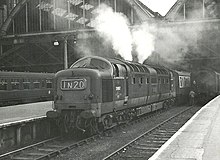Napier Deltic
A single, half-sized, turbocharged Deltic power unit also featured in the English Electric-built Type 2 locomotive, designated as the Class 23.
The Deltic story began in 1943 when the British Admiralty set up a committee to develop a high-power, lightweight diesel engine for motor torpedo boats.
[1] Hitherto in the Royal Navy, such boats had been driven by petrol engines, but their highly flammable fuel made them vulnerable to fire, unlike diesel-powered E-boats.
A patent for an engine, similar in complexity, but with four lines of pistons, not just three, was filed in 1930 by Wifredo Ricart, linked to Alfa Romeo, and to the Spanish INI truck maker Pegaso, Pat ES0118013.
The result was a triangle, the cylinder banks forming the sides, with crankshafts at each corner connected by phasing gears to a single output shaft—effectively three separate V-12 engines.
Herbert Penwarden, a senior draughtsman with the Admiralty Engineering Laboratory, suggested that one crankshaft needed to revolve anticlockwise to achieve the correct piston-phasing, so Napier designers produced the necessary gearing so one of them rotated in the opposite direction to the other two.
This led to the even, buzzing exhaust note of the Deltic, with a charge ignition every 20° of crankshaft revolution, and a lack of torsional vibration, ideal for use in mine-hunting vessels.
Interlacing firing events over all three banks of cylinders still leads to an even buzzing exhaust note, and charge ignition occurring every 40° of crankshaft revolution with consequent reduction of torsional vibration.
[1] Proving successful, Deltic Diesel engines became a common power plant in small and fast naval craft.
Being largely of aluminium construction, their low magnetic signature allowed their use in mine countermeasures vessels and the Deltic was selected to power the Ton-class minesweepers.
The New York City Fire Department used a Napier Deltic engine to power their one-of-a-kind "Super Pumper System".
[12] While the Deltic engine was successful in marine and rail use and very powerful for its size and weight, it was a highly strung unit, requiring careful maintenance.
Deltic engines were easily removed after breakdown, generally being sent back to the manufacturer for repair, although after initial contracts expired both the Royal Navy and British Railways set up their own workshops for overhauls.
[14] Naval interest had waned by 1958 in favour of the pure gas turbine, despite its heavier fuel consumption, and no further development was carried out.




